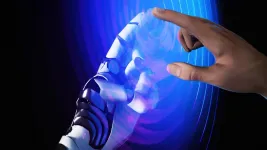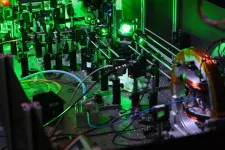(Press-News.org) Scientists in China have developed a small, flexible device that can convert heat emitted from human skin to electrical power. In their research, presented April 29 in the journal Cell Reports Physical Science, the team showed that the device could power an LED light in real time when worn on a wristband. The findings suggest that body temperature could someday power wearable electronics such as fitness trackers.
The device is a thermoelectric generator (TEG) that uses temperature gradients to generate power. In this design, researchers use the difference between the warmer body temperature and the relatively cooler ambient environment to generate power.
"This is a field with great potential," says corresponding author Qian Zhang of Harbin Institute of Technology, Shenzhen. "TEGs can recover energy that's lost as waste heat and thus improve the rate of power utilization."
Unlike traditional generators that use the energy of motion to produce power, thermoelectric generators have no moving parts, making them essentially maintenance free. These generators are installed on machines located in remote areas and on board space probes to supply energy.
Zhang and her colleagues have been working on designing thermoelectric generators for years. With wearable devices becoming increasingly popular in recent years, the team wanted to explore whether these reliable generators could replace traditional battery in these devices, including fitness trackers, smart watches, and biosensors.
"Don't underestimate the temperature differences between our body and the environment--it's small, but our experiment shows it can still generate power," she says.
Conventional TEGs are usually rigid and can only withstand fewer than 200 instances of bending. Although the flexible kinds can meet the bending requirement, their performance tends to be inadequate. To overcome this limitation and make the device more adaptable to wearables, researchers attached the core electrical components to a stretchable and more adhesive polyurethane material. Tests showed that the device survived at least 10,000 instances of repeated bending without significant changes in performance.
In addition, commercially available TEGs rely heavily on rare metal bismuth that does not naturally occur in large quantities. The new design partially replaced it with a magnesium-based material, which can substantially lower the costs in large-scale production.
Researchers designed a prototype of a self-powered electronic system. They connected an LED to a TEG band measuring 4.5 in long and 1.1 in wide. Then, the team wrapped the TEG band around the wrist of someone whose body temperature measured at 92.9?F in ambient environmental conditions. With a temperature difference, the generator harvested heat given off from the skin and successfully lit up the LED.
"Our prototype already has good performance if it's introduced to the market," says corresponding author Feng Cao of Harbin Institute of Technology, Shenzhen. He adds that with the proper voltage converter, the system can power electronics such as smart watches and pulse sensors.
Looking forward, the team plans to further improve the design so the device can absorb heat more efficiently.
"There's an increasing demand for greener energy, and TEGs fit right in, for they can turn wasted heat into power," Cao says. "While, for example, solar energy can only be generated when there's sun, TEGs can produce power in many scenarios--as long as there's a temperature difference."
INFORMATION:
This work was supported by the National Natural Science Foundation of China, the Natural Science Foundation of Guangdong Province of China, the Natural Science Foundation for Distinguished Young Scholars of Guangdong Province of China, Shenzhen Science and Technology Innovation Plan, Open Fund of Jiangsu Key Laboratory of Electrochemical Energy Storage, and the Natural Scientific Research Innovation Foundation in Harbin Institute of Technology.
Cell Reports Physical Science, Liu et al.: "Efficient Molecular Encoding in Multifunctional Self-Immolative Urethanes" https://www.cell.com/cell-reports-physical-science/fulltext/S2666-3864(21)00102-8
Cell Reports Physical Science (@CellRepPhysSci), published by Cell Press, is a new broad-scope, open access journal that publishes cutting-edge research across the spectrum of the physical sciences, including chemistry, physics, materials science, energy science, engineering, and related interdisciplinary work. Visit: https://www.cell.com/cell-reports-physical-science/home. To receive Cell Press media alerts, please contact press@cell.com.
It may seem like an unusual place to go looking for answers, but the contents of a baby's first diaper can reveal a lot about a newborn's future health.
In a new study published today in Cell Reports Medicine, a team of University of British Columbia (UBC) researchers has shown that the composition of a baby's first poop--a thick, dark green substance known as meconium--is associated with whether or not a child will develop allergies within their first year of life.
"Our analysis revealed that newborns who developed allergic sensitization by one year of age had significantly less 'rich' meconium at birth, compared to those who didn't develop allergic sensitization," says the study's senior co-author Dr. Brett Finlay, a professor at the Michael Smith ...
Although robotic devices are used in everything from assembly lines to medicine, engineers have a hard time accounting for the friction that occurs when those robots grip objects - particularly in wet environments. Researchers have now discovered a new law of physics that accounts for this type of friction, which should advance a wide range of robotic technologies.
"Our work here opens the door to creating more reliable and functional haptic and robotic devices in applications such as telesurgery and manufacturing," says Lilian Hsiao, an assistant professor of chemical and biomolecular engineering at North Carolina State University and corresponding author of a paper on the work.
At ...
The best path across the desert is rarely the straightest. For the first human inhabitants of Sahul -- the super-continent that underlies modern Australia and New Guinea -- camping at the next spring, stream, or rock shelter allowed them to thrive for hundreds of generations. Those who successfully traversed the landmarks made their way across the continent, spreading from their landfall in the Northwest across the continent, making their way to all corners of Australia and New Guinea.
By simulating the physiology and decisions of early way-finders, an international team* of archaeologists, geographers, ecologists, and computer scientists has mapped the probable "superhighways" that led ...
BOSTON - Concerns about fertility often influence how young women with breast cancer approach treatment decisions and are a reason for forgoing or delaying hormone-blocking therapy, a new study by Dana-Farber Cancer Institute investigators shows.
The findings, published online today by the journal Cancer, reinforce the need for physicians to talk with patients about their fertility-related priorities and address them in treatment plans, the study authors write. Such conversations are important not only at the start of treatment but during its entire course, as patients' goals ...
Scientists from the University of Bristol's Quantum Engineering Technology Labs (QETLabs) have developed an algorithm that provides valuable insights into the physics underlying quantum systems - paving the way for significant advances in quantum computation and sensing, and potentially turning a new page in scientific investigation.
In physics, systems of particles and their evolution are described by mathematical models, requiring the successful interplay of theoretical arguments and experimental verification. Even more complex is the description of systems of particles interacting with each other at the quantum mechanical level, which is often done using a Hamiltonian model. The process of formulating Hamiltonian models from observations is made even harder by the nature ...
'Superhighways' used by a population of up to 6.5 million Indigenous Australians to navigate the continent tens of thousands of years ago have been revealed by new research using sophisticated modelling of past people and landscapes.
The new insights into how people not only survived, but thrived, in harsh environments provide further evidence of the capacity and resilience of the ancestors of Indigenous people, and help paint a picture of large, well-organised groups navigating tough terrain.
The 'peopling' of Sahul -- the combined mega continent that joined Australia with New Guinea when ...
There was a hope that as more plants start to grow in Arctic and boreal latitudes as our warming climate makes those regions more hospitable for plants, those photosynthesizing plants would work to help sequester the atmospheric carbon dioxide that helped them flourish in the first place. But new research led by scientists at UC Irvine and Boston University, out in Nature Climate Change, suggests that all the new green biomass is not as large a carbon sink as scientists had hoped.
"What does greening really mean? Can we really trust it to save us from climate change?" said Jon Wang, an Earth system scientist at UCI who the led the work alongside BU Earth & Environment professor Mark Friedl. "A big question is: What'll happen to the carbon that's currently ...
What The Study Did: This survey study examines the associations of school closure and exposure to COVID-19-related stressors with caregivers' perceptions of their children's mental well-being.
Authors: Tali Raviv, Ph.D., of the Ann and Robert H. Lurie Children's Hospital of Chicago, is the corresponding author.
To access the embargoed study: Visit our For The Media website at this link https://media.jamanetwork.com/
(doi:10.1001/jamanetworkopen.2021.11103)
Editor's Note: The article includes conflict of interest disclosures. Please see the article ...
What The Study Did: Using insurance claims data, the change in screening rates for breast, colorectal and prostate cancers during the COVID-19 pandemic were estimated as well as the overall decline in cancer screening last year among the U.S. population.
Authors: Ronald Chen, M.D., M.P.H., of the University of Kansas in Kansas City, is the corresponding author.
To access the embargoed study: Visit our For The Media website at this link https://media.jamanetwork.com/
(doi:10.1001/jamaoncol.2021.0884)
Editor's Note: The article includes conflicts of interest disclosures. Please see the article for additional information, including other authors, author contributions and affiliations, conflict of interest and financial disclosures, and funding and support.
INFORMATION:
Media ...
What The Study Did: This case series investigates the frequency and type of SARS-CoV-2 nasopharyngeal test complications in Helsinki, Finland.
Authors: Anni Koskinen, M.D., Ph.D., of the Helsinki University Hospital in Finland, is the corresponding author.
To access the embargoed study: Visit our For The Media website at this link https://media.jamanetwork.com/
(doi:10.1001/jamaoto.2021.0715)
Editor's Note: Please see the article for additional information, including other authors, author contributions and affiliations, conflict of interest and financial disclosures, and funding and support.
INFORMATION:
Media advisory: The full article is linked to this news release.
Embed this link to provide your readers free access to the full-text article This ...



